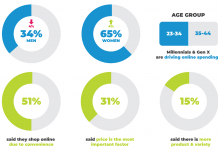According to Kenne Loubser, Head of Marketing at Payflex, the unprecedented digital disruption experienced in retail last year has made the industry increasingly digital and internet-driven, with technology playing a key role in providing experiences in line with customers’ needs.
Agility, flexibility and rich online shopping experiences are set to be among the key trends driving retail in the significantly reshaped retail landscape of 2021. Loubser spotlights the top eight online retail trends expected to shape the online retail sector in 2021:
1. Blurred lines
Physical channels and e-commerce will no longer be perceived as separate entities as consumers increasingly demand an integrated shopping experience. They might browse an e-commerce site on their mobiles but ultimately make a purchase from a desktop. Or they might pay online, but pick up the purchased item in-store.
Retailers can capitalise on this hybrid approach by creating omnichannel offerings. This means customers can convert or make the decision to buy something at multiple touchpoints.
2. Need for speed
Leveraging timeously order fulfilment is key to customer satisfaction. This means an efficient logistics and supply chain infrastructure, complemented by alternative delivery options such as BOPIS (Buy online, pay in-store) and click and collect. If you want to foster shopper loyalty and strengthen relationships, simply meet your customer’s shipping expectations. It is that simple. Deliver orders rapidly and accurately.
3. Securing online security
2021 will see an emphasis on visuals denoting online security and transparency about the use of data to allay customer concerns about sharing their financial information. This includes displaying safety tools on payment pages such as security banners, certification seals like VeriSign, Thawte, showing PCI compliance and SSL certification.
4. Optimising user experience
Focus is on providing the shopper with a streamlined and flexible shopping solution such as intuitive navigation or providing an online chat facility – all elements that contribute to an easy, safe and frictionless experience. Simplicity is the key, enabling the user to effortlessly navigate the website and find and acquire the desired items.
A single-click checkout process dramatically increases sales conversions. Every e-tailer should consider it for returning customers. The more steps during payment, the higher chance of your customer abandoning their cart.
5. New purchasing channels
E-commerce is increasingly making its way into consumers’ social media and video feeds via social commerce. This has seen Facebook introducing Shops in 2020, enabling merchants to set up a storefront with exposure to the global audiences on both the Instagram and Facebook platforms.
Social commerce is like the democratisation of e-commerce. It opens the doors of e-commerce to anyone. This goes for both small and large-scale retailers. The world of social media is open to anyone who wants to truly engage with their customers.
6. Supporting consumer financial constraints
According to TransUnion’s Financial Hardship Survey, 82% of consumers indicated their household income had been impacted, with expectations of a shortfall of R7069.90 when paying bills or loans. We will see an increase in flexible payment solutions to accommodate consumer finances, assisting their ‘cash flow’ without incurring further debt associated with credit cards.
7. Personalised commerce
The Covid-conscious consumer is wanting to replicate interactive personalised experiences and services within a safe and contactless context. Immersive commerce like augmented reality (AR) and 3D are giving shoppers a rich, interactive and personalised experience to bridge the gap between the digital and the physical.
The introduction of Shopify AR, which facilitates showcasing of brand products to shoppers, is a case in point which saw a 94% higher conversion rate than products without AR. Technology is helping to replicate key elements of the in-store experience with 64% of leading consumer brands starting to invest in immersive experiences in order to boost consumer confidence, enhance loyalty and foster more tailored online interactions.
8. Reinventing shopping
Shopstreaming, the art of combining live streaming and e-commerce, is set to trend in the retail industry. Allowing a customer to digitally ‘walk’ around a store and watch brand ambassadors explain their products, shopstreaming even enables interacting with other people in the store as if the shopper was actually there.
While uptake in the West has been slower than China, brands are rapidly catching onto this nascent trend driven by the popularity of live-streaming among Gen Z and millennials. Through live streaming, influencers can engage potential consumers at scale on a daily basis.
A brave new retail world
As we enter the new year, what consumers want, and how they want it, continues to evolve. Agility will always be a key weapon in a retailer’s arsenal. The uncertainty is not over and merchants will continue to contend with in this delicate industry. However, we can be sure that digital-led experiences will undoubtedly continue to grow in popularity in 2021. Retailers that embrace technology to innovatively address new consumer pain points and evolving shopper behaviour will gain the advantage and win the race for attention and buyers.











